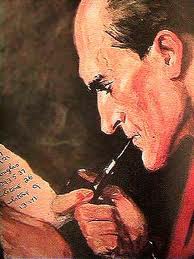Conned By The Force

Con artist.
(Warning: spoilers ahead.)
I finally got around to seeing Star Wars: The Force Awakens the other day. It was pretty much what I expected – lots of action, lots of explosions, and a shocking shortage of suggestive double entendres. It’s a very earnest movie.
Here’s what I didn’t expect: I didn’t expect to be conned. But, boy, was I ever. And I fell for it like … well, like a death star falling into a black hole.
As always, it’s a story of good and evil, of course. The vile, evil bad guy is Kylo Ren who dresses like a fashionable Darth Vader. Though we can’t see his face, we know he’s young — the script tells us so several times. Since he’s young, we assume he’s impressionable and, perhaps, redeemable.
And redmption is exactly what we expect when an aging Han Solo confronts him, man-to-man and mano-a-mano. We’re just sure that the wise and wizened Han can save Kylo’s young soul and bring him back to the bright side. (Cue Monty Python: always look on the bright side of life).
And it works! Kylo drops his mask. His eyes fill with tears. His lips tremble. With evident emotion, he hands Han his most terrible weapon, the lightsaber. Han reaches for the weapon and we’re convinced that Kylo is about to be redeemed. Han grasps the saber and we know that angelic music will soon swell to celebrate Kylo’s conversion.
But, no. It doesn’t work out that way. I was conned. More to the point – and with much more devastating effect – Han was conned.
As I look back on the scene, I think: I should have seen that coming from a parsec away. But I didn’t. I wanted to believe. I got conned.
Why was I conned? According to Maria Konnikova, it’s because I wanted to be conned. In her new book, The Confidence Game, Konnikova writes that the con game is “…the oldest story ever told.” Simply put, we’re wired to believe. We want to believe. If we’re unsure about the future, we want someone to tell us a story to reassure us. It doesn’t have to be logical. It simply has to be believable. Since we want desperately to believe, the bar is set pretty low.
The Kylo Ren con also worked on me because I already knew the story. It’s the prodigal son. I’ve always loved the story of the prodigal son, perhaps because I was one. So I was primed. I knew how it’s supposed to end. I half-expected Han to kill a fatted calf and say, My son was lost but now he is found. That’s the way it always happens, doesn’t it? That’s what I want to believe.
Konnikova writes that we ultimately are the enablers of con artists:
“In some ways, confidence artists … have it easy. We’ve done most of the work for them; we want to believe in what they’re telling us. Their genius lies in figuring out what, precisely, it is we want and how they can present themselves as the perfect vehicle for delivering on that desire.”
So how can we protect ourselves against con artists? More on that in future articles. In the meantime, you might consider some traditional Minnesota wisdom: You’re not so special.
How We Think And What It Means

Let’s think about this.
We have not one but two thinking systems in our heads. Daniel Kahneman, a Nobel laureate in economics, dubs them System 1 and System 2. System 1 is fast, automatic, energy efficient, subconscious, and always on. We don’t think about it; it thinks for us. Some observers claim that System 1 makes 95% of our decisions. We merrily mosey along, not even aware that we’re making decisions.
We are, on the other hand, aware of System 2. When we think about thinking, we’re thinking about System 2. It’s our conscious self. It’s where we consider ideas, weigh evidence, and reach conclusions. Unfortunately, System 2 is an energy hog so we use it sparingly. Like other forms of exercise, System 2 requires effort, practice, and discipline. It’s hard.
We get by most of the time on System 1. Usually that’s fine – System 1 makes a lot of good decisions. But not all the time. System 1 produces biases like stereotyping, temporizing, risk aversion, and unbridled fear. If we don’t have an effective, well-tuned System 2 to overcome those biases, we can do a lot of damage to ourselves and others.
Maria Konnikova (pictured), in her lovely book, Mastermind: How To Think Like Sherlock Holmes, compares System 1 to Watson and System 2 to Holmes. System Watson represents “…our naïve selves, operating by the lazy thought habits … that we’ve spent our whole lives acquiring….” On the other hand, System Holmes, represents “… our aspirational selves, the selves that we’ll be once we’re done learning how to apply his method of thinking to our everyday lives and, in so doing break the habits of our Watson system once and for all.”
System Watson comes to us naturally. System Holmes needs to be learned, practiced, and mastered. As Konnikova notes, “…to break from that autopiloted [Watson] mode, we have to be motivated to think in a mindful, present fashion, to exert effort on what goes through our heads instead of going with the flow.”
David Brooks, in the Social Animal: The Hidden Sources of Love, Character, and Achievement, describes our bias towards the conscious mind (System 2): “The conscious mind writes the autobiography of our species. Unaware of what is going on deep down inside, the conscious mind assigns itself the starring role. It gives itself credit for performing all sorts of tasks it doesn’t really control.”
Brooks compares the conscious mind to ”… a general atop a platform, who sees the world from a distance and analyzes things linearly and linguistically….” The unconscious mind, “…is like a million little scouts [that] … careen across the landscape, sending back a constant flow of signals and generating instant responses. They maintain no distance from the environment, but are immersed in it. They scurry about, interpenetrating other minds, landscapes, and ideas.”
For Brooks, the individual is the star in the “outer mind”. In contrast, “… the inner mind highlights the power of relationships and the invisible bonds between people. If the outer mind hungers for status, money, and applause, the inner mind hungers for harmony and connection….”
From Kahneman, we learn about the native biases of System 1 and an important implication: we’re not rational when it comes to economic matters. This is the insight that won the Nobel Prize. From Konnikova, we learn how to observe and deduce. The implication: with sufficient motivation, we can indeed learn to overcome our biases. From Brooks, we learn that System 2 is an individualist while System 1 is a collectivist. The implication: this duality is an important source of tension in the body politic.
What else can we learn by comparing System 1 to System 2? Let’s talk more about that tomorrow.
Seeing And Observing Sherlock

Pardon me while I unitask.
I’m reading a delightful book by Maria Konnikova, titled Mastermind: How To Think Like Sherlock Holmes. It covers much of the same territory as other books I’ve read on thinking, deducing, and questioning but it reads more like … well, like a detective novel. In other words, it’s fun.
In the past, I’ve covered Daniel Kahneman’s book, Thinking Fast and Slow. Kahneman argues that we have two thinking systems. System 1 is fast and automatic and always on. We make millions of decisions each day but don’t think about the vast majority of them; System 1 handles them. System 1 is right most of the time but not always. It uses rules of thumb and makes common errors (which I’ve cataloged here, here, here, and here).
System 1 can also invoke System 2 – the system we think of when we think of thinking. System 2 is where we logically process data, make deductions, and reach conclusions. It’s very energy intensive. Thinking is tiring, which is why we often try to avoid it. Better to let System 1 handle it without much conscious thought.
Kahneman illustrates the differences between System 1 and System 2. Konnikova covers some of the same territory but with slightly different terminology. Konnikova renames System 1 as System Watson and System 2 as System Holmes. Konnikova proceeds to analyze System Holmes and reveal what makes it so effective.
Though I’m only a quarter of the way through the book, I’ve already gleaned a few interesting tidbits, such as these:
Motivation counts – motivated thinkers are more likely to invoke System Holmes. Less motivated thinkers are willing to let System Watson carry the day. Konnikova points out that thinking is hard work. (Kahneman makes the same point repeatedly). Motivation helps you tackle the work.
Unitasking trumps multitasking – Thinking is hard work. Thinking about multiple things simultaneously is extremely hard work. Indeed, it’s virtually impossible. Konnikova notes that Holmes is very good at one essential skill: sitting still. (Pascal once remarked that, “All of man’s problems stem from his inability to sit still in a room.” Holmes seems to have solved that problem).
Your brain attic needs a spring cleaning – we all have lots of stuff in our brain attics and – like the attics in our houses – a lot of it is not worth keeping. Holmes keeps only what he needs to do the job that motivates him.
Observing is different than seeing – Watson sees. Holmes observes. Exactly how he observes is a complex process that I’ll report on in future posts.
Don’t worry. I’m on the case.